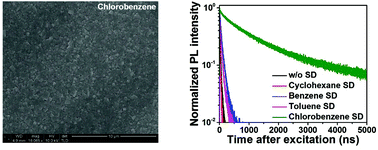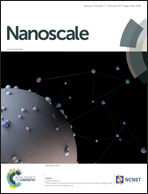Effect of the solvent used for fabrication of perovskite films by solvent dropping on performance of perovskite light-emitting diodes†
Abstract
Organic–inorganic hybrid perovskites have emerged as a next-generation candidate for light-emitting device applications due to their excellent optical and electrical properties with narrow band emission compared to organic emitters. The morphological control of perovskite films with full surface coverage and few defect sites is essential for achieving highly efficient perovskite light-emitting diodes (PeLEDs). Here, we obtain a highly uniform perovskite film with a remarkably reduced number of defect sites in a perovskite crystal using chlorobenzene dropping. This effort leads to the enhanced performance of PeLEDs with a CH3NH3PbBr3 film using chlorobenzene dropping with a maximum luminance of 14 460 cd m−2 (at 3.8 V) and a maximum external quantum efficiency (EQE) of 0.71% (at 2.8 V). This research confirms that the role of the solvent in the solvent dropping method is to fabricate a dense and uniform perovskite film and to passivate the defect sites of the perovskite crystal films.

- This article is part of the themed collection: Editor’s Choice: Perovskite Nanomaterials and Devices


 Please wait while we load your content...
Please wait while we load your content...